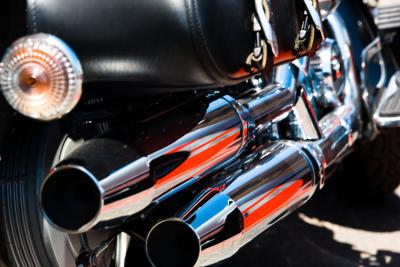
"Turbo" mufflers may not be what you think they are; the name itself is somewhat deceptive, being more of a nickname derived from the design's original application than a descriptor of its construction. Call them what you want to -- turbo, glasspack or cherry bomb -- but no matter what they're called, you're talking about a design whose performance and signature sound have made it an enduring presence for longer than many hot-rodders have been alive.
Manufacturers can call their mufflers anything they want to -- Turbo, Cherry Bomb, Ultimate Titanium Reverse-Flow Carbuncle -- but the term "turbo muffler" actually hearkens back to the 1962 to 1969 Chevrolet Corsair. Chevy's "unsafe at any speed" sports car had a very unusual drivetrain layout: rear-engine, rear-drive and a horizontally opposed -- or "boxer" -- six-cylinder engine equipped with a turbocharger. This unusual package made for odd packaging, and Chevy had to engineer a very simple, straight-through muffler to fit into the confines of the Corsair's engine bay. This style of "turbo" -- shorthand for "turbocharged" Corvair -- muffler proved a very popular retrofit with musclecar enthusiasts, who loved it for its compact dimensions and excellent flow.
The turbo Corvair's muffler quickly gained the nickname "cherry bomb," referring to the incredible noise it produced when paired with massive muscle engines. The traditional "turbo" or "cherry bomb" muffler is a straight-through design. It consists of a perforated inner tube through which exhaust gases flow, a round or oval-shaped casing around the tube and a bunch of fiberglass packing in-between. This is where it gets yet another of its names: the "glasspack."
Exhaust comes out of your engine in pressure pulses. These pulses are essentially waves of energy that move through the exhaust stream, manifesting as noise when they come out of the exhaust pipe. The standard glasspack does two things. First, the wider outer casing acts as an expansion chamber that forces the pressure waves to slow down and expend some of their energy before exiting. This alone is enough to help quiet the muffler and reduce irritating high-frequency soundwaves, but the fiberglass packing in-between the central tube and casing ups the ante even more by flexing to turn some of the pressure-wave energy into movement. Oval-shaped straight-through mufflers, with their larger expansion chambers, can absorb even more energy, making them better at controlling sound than tubular mufflers.
The straight-through glasspack is like a shotgun: far from sophisticated, but fairly effective nonetheless. The glasspack flows nearly as well as a perfectly straight section of tube -- no surprise there -- but leaves a lot to be desired in terms of sound control. The straight-through design provides no physical barrier between the engine and exhaust tip, nothing for pressure waves to bounce back on. Bouncing the pressure waves back on themselves returns energy to the incoming waves, canceling them out and killing the sound energy altogether. Some glasspack designs use a somewhat hybridized approach, using one or more walls or "bulkheads" between the central tube and outer casing to create several separate chambers. This aids in sound reflection and allows for more precise control of frequency output.